Alex Cheong Pui Yin
5th April 2024 - 24 min read

Welcome back to another edition of our comprehensive annual income tax guide, this time to help you out with your tax filing process in 2024 for the 2023 year of assessment (YA)! It’s undeniable that tax filing can be a painstaking process for many people, and can even be intimidating for some, but with some assistance and guidance, you can file taxes with confidence and ease – and maximise tax refunds where possible.
As with previous years, we’ll once again highlight various key details that you should take note of during different stages of the process, so that you don’t miss out on things. With that, let’s get started.
Do you need to pay income tax?

Individuals who earn more than RM34,000 per annum after EPF deductions (approximately RM2,833.33 per month) are required to register a tax file. This figure does not only encompass your monthly salary, but also all other types of income, including earnings from your business or profession, employment, dividends, interest, discounts, rent, royalties, premiums, pensions, annuities, and others.
In the case of salaried individuals, make sure to also calculate any other taxable earnings on top of your salary, such as bonuses, overtime, and commissions. Freelancers and part-timers, too, are not spared from registering and filing their taxes if their annual income exceeds the RM34,00 mark.
Meanwhile, individuals who are earning income from abroad (foreign-sourced income) are exempted from paying taxes – but only if you are already taxed in the country of origin. This arrangement will be valid until 31 December 2026.
If you’re not sure which income needs to be declared for tax purposes, we’ll be sharing more on this in a later sub-section of this guide (“How To File Income Tax In Malaysia” >> “Declare Your Income”), so hang tight for now!
Malaysia tax rates & chargeable income (YA 2023)

The tax rate that is applicable to you as an individual taxpayer is determined by your chargeable income (also known as taxable income). It is calculated by taking your total annual income, and subtracting all the tax exemptions and tax reliefs that you are entitled to.
Here are the updated tax rates for YA 2023:
| Chargeable Income (RM) | Calculations (RM) | Rate % | Tax (RM) |
| 0 – 5,000 | On the first 5,000 | 0 | 0 |
| 5,001 – 20,000 | On the first 5,000 Next 15,000 | 1 | 0 150 |
| 20,001 – 35,000 | On the first 20,000 Next 15,000 | 3 | 150 450 |
| 35,001 – 50,000 | On the first 35,000 Next 15,000 | 6 | 600 900 |
| 50,001 – 70,000 | On the first 50,000 Next 20,000 | 11 | 1,500 2,200 |
| 70,001 – 100,000 | On the first 70,000 Next 30,000 | 19 | 3,700 5,700 |
| 100,001 – 400,000 | On the first 100,000 Next 300,000 | 25 | 9,400 75,000 |
| 400,001 – 600,000 | On the first 400,000 Next 200,000 | 26 | 84,400 52,000 |
| 600,001 – 2,000,000 | On the first 600,000 Next 1,400,000 | 28 | 136,400 392,000 |
| Exceeding 2,000,000 | On the first 2,000,000 Every next ringgit | 30 | 528,400 ……….. |
As you can see, the tax rate you are charged with increases as your chargeable income does. As such, the more you reduce your chargeable income – through tax reliefs and other eligible incentives – the lesser your final tax amount will be.
Here’s an example: let’s say your chargeable income is RM48,000. This means that your tax rate is 8%, and the total income tax that you must pay is RM1,380 (RM600 + RM780). However, if you’re able to claim RM13,500 in tax deductions and tax reliefs, then your chargeable income will drop to RM34,500, which means that your tax rate, too, will be lowered to 3%. In turn, the amount of tax that you need to pay is decreased to RM585 – almost RM800 in difference!
For YA 2023, it’s important to note that the tax rates have been amended under Budget 2023, with a reduction of 2% for those who fall under the M40 income group, and an increase of between 0.5% to 2% for selected higher income brackets. This decision was meant to help M40 individuals cope with the rising cost of living by providing them with more disposable income.
Tax filing for foreigners (residents & non-residents)

Foreigners and expatriates who have worked and earned income in Malaysia for a specified period are required to pay income tax too.
Those who have been working in Malaysia for more than 182 days (referred to as residents) are eligible to be taxed under normal Malaysian income tax laws and rates – just like the regular Malaysian taxpayer.
Meanwhile, if you stay in Malaysia for less than 182 days and are employed for at least 60 days (referred to as non-residents), you are subjected to a flat rate based on your types of income:
| Types of income | Rate (%) |
| – Business, trade, or profession – Employment – Dividends – Rent | 30 |
| – Public entertainer – Interest | 15 |
| – Royalty – Payments for services in connection with the use of property or installation, operation of any plant or machinery purchased from a non-resident – Payments for technical advice, assistance, or services rendered in connection with technical management or administration of any scientific, industrial, or commercial undertaking, venture, project, or scheme – Rent or other payments for the use of any movable property | 10 |
For further clarification, foreigners will not be taxed if they meet the following conditions:
- Employed in Malaysia for less than 60 days
- Employed on board a Malaysian ship
- Age 55 years old and receiving pension from Malaysian employment
- Receiving interest from banks
- Receiving tax exempt dividends
How to file income tax in Malaysia

Now let’s get down to the actual tax filing process. The tax return form that you need to use is dependent on the type of income that you earn. Specifically:
- Resident individuals who do not carry on a business: BE Form
- Resident individuals who carry on a business: B Form
- Non-residents (foreigners): M Form
There are more forms and classifications to this, but more on this under the “Accessing e-Filing and your ITRF” sub-section below!
In the meantime, note that the deadline for filing income tax in Malaysia will vary according to the type of form that you’re filing. For those who are filling in the BE Form (residents who do not carry on a business), your deadline falls on either 30 April 2024 (manual filing) or 15 May 2024 (e-Filing). Meanwhile, those who are filling in the B form (residents who carry on business) are required to do so by 30 June 2024 (manual filing) or 15 July (e-Filing).
Next up, we’ll go through the whole tax filing process with you, step by step:
1) Registering as a first-time taxpayer on e-Daftar

For those who are filing their taxes online for the first time, there are two things that you must have before you can start:
- Income tax number (to indicate that you are a registered taxpayer)
- One-time PIN to register for e-Filing (the platform where you submit your income tax return form (ITRF))
Let’s start with the first: your income tax number. To get this, you’ll need to first register as a taxpayer on e-Daftar (which you can access on LHDN’s one-stop portal, MyTax). Once you’ve received your income tax number, you can then obtain your PIN for e-Filing either online or by visiting a LHDN branch. For a more detailed explanation on how to register as a first-time taxpayer, check out our comprehensive guide here.
Otherwise, you can also check out this infographic, which summarises the whole journey of registering as a taxpayer and obtaining your PIN for e-Filing:

2) Accessing e-Filing and your ITRF via MyTax
Existing taxpayers, meanwhile, can skip Step 1 above, and go straight to the MyTax website to access e-Filing and start filling up their income tax return form (ITRF). Just a note, remember that you can toggle the language for the MyTax and e-Filing website (including your ITRF) between Bahasa Malaysia and English, so opt for whichever you’re most comfortable with – this will make your tax filing journey much easier!
Upon logging into your MyTax account, you’ll be taken to your dashboard, which will display information such as your tax balance and refund amount. To access e-Filing, click on “EzHasil Services”, and then click on “e-Filing” in the dropdown list.

Once you’re on the right page, go ahead and click on “e-BE Year of Assessment 2023” (or whichever form that is applicable to you) to get to your ITRF quickly. Those who do not have the quick link, or need to choose a new form because their source of income has changed will need to click on “e-Form” to select their ITRF instead.

As you make your selection, be sure to choose the right type based on the category of income that you fall under:
| Income tax | Category |
| e-B/e-BT | For residents earning income from business/knowledge or expert workers |
| e-BE | For residents earning income without a business |
| e-M/e-MT | For non-resident individuals/knowledge workers |
You can also find the full list of other types of forms (including for partnerships, associations, and deceased persons’ estate) on the LHDN website here.

On top of choosing the right form, make sure to also select the right year of assessment: YA 2023! Remember, you’re declaring your income earned for the previous year.
3) Filling up your ITRF
Now let’s get right down to the bottom of filling out your income tax form (for residents earning income without a business)! We’ll take you through the different sections in your form:
i) Particulars of individual
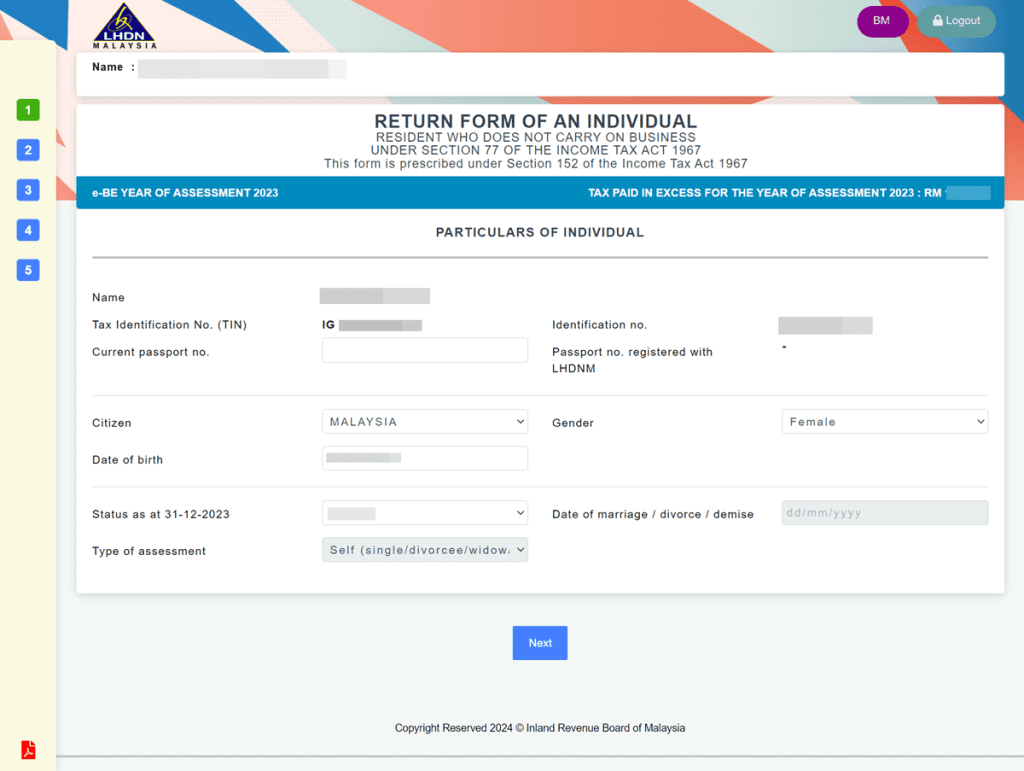
This section is all about your basic personal details. Some of them will have already been filled out for you – such as your identification number and date of birth – but it’s always good practice to double check for accuracy. You should also make sure to select the right type of assessment, which determines whether you are filing as a single person, or filing together/separately with your spouse.
ii) Other particulars

This continues from the previous section. In this section, be sure to check that your handphone number is correct as you will need to obtain a TAC from LHDN when you sign and submit your e-form later.
Additionally, ensure that your bank account number is accurate so that you’ll get your tax refund (if any) without any mishaps. You can also choose to receive your tax refund via DuitNow, if you prefer; simply select your preferred method under “Method of payment for tax refund”, and fill in the necessary information.
Make sure to also update the Employer’s Number if you’ve changed employers in the previous year. Also, be sure to tick “yes” under “Tax borne by employer” if your job comes with the benefit of having your income tax paid by your employer (i.e. tax allowance is part of your gross income from your employment).
Meanwhile, the disposal of asset under the Real Property Gains Tax Act 1976 will only apply to you if you’ve sold any properties in the previous year.
You’ll also find the section for Incentive Claims under paragraph 127(3)(b) and subsection 127(3A) here, which is related to specific exemptions made under gazette orders and exemptions given by the Minister of Finance. Leave this section blank if it is not relevant to you.
iii) Declare your income
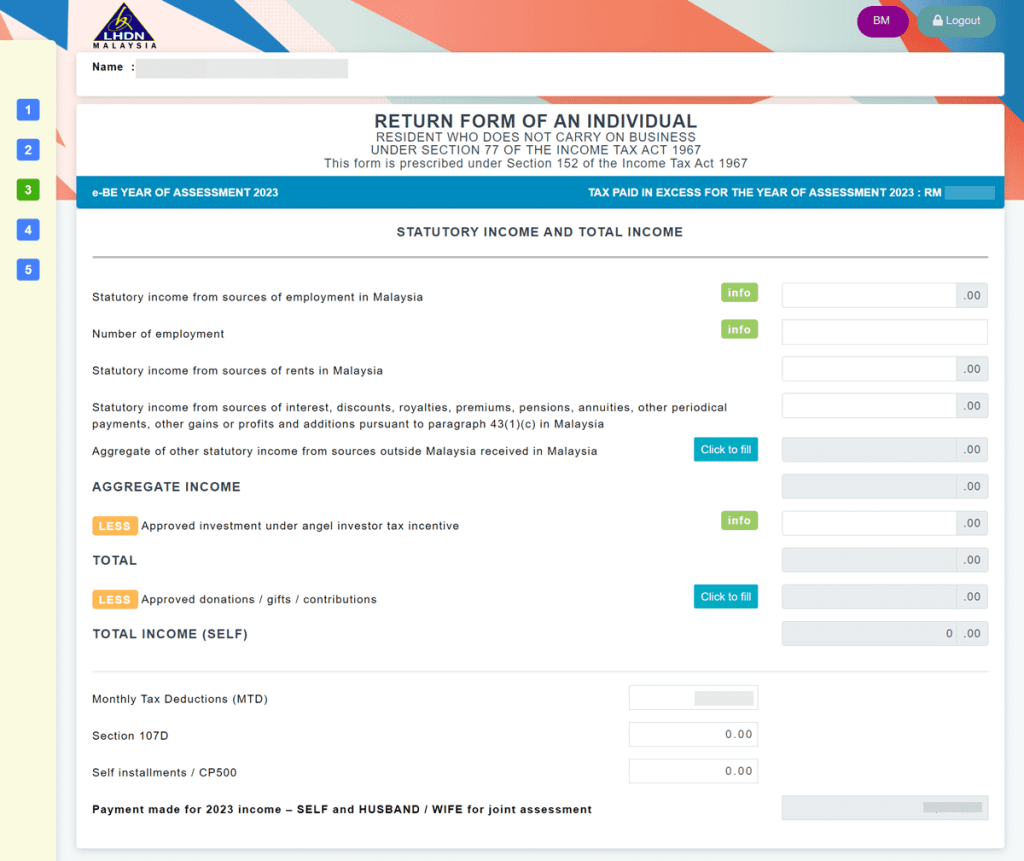
Fill in your total income earned for the year under statutory income; this includes what you’ve earned through your employment, rents, and other sources in the respective boxes. This is where your EA form will be come into play as it states your annual income earned from your employer.
Be aware, though, that although the EA form is helpful, you will still need to scrutinise the figures prior to keying them into your ITRF. This is because for some individuals, the annual income stated in the EA form may not necessarily be the final figure for your statutory income from employment. You are also required to declare any non-salary related benefits that can also count as “income from employment” – meaning they, too, must be added to your income figure. These include income from rents, interests, discounts, royalties, premiums, pensions, periodical payments, as well as payments received for part-time and occasional jobs (broadcasting, lecturing, writing, and so on).
Conversely, remember to exclude any income that is entitled to tax exemptions on your form. For example, perquisites (which cover things like parking, medical, and travel/transport allowance) and benefits-in-kind (such as cars, personal drivers, accommodation, and so on) are taxable under law, but the government has provided some tax exemptions for them. Your severance package, too, may be exempted from tax under certain conditions.
The form will automatically total up all the figures that you’ve keyed in to show you your aggregate income (total income that you’ve earned in the year). The next step is to calculate the tax deductions that you may be entitled to, so that you can reduce your aggregate income. If you’ve donated to registered charity organisations or gifts to eligible entities, then you can make a tax deduction from your aggregate income. This will give you your total income.
In this section, you’ll also have to key in the total monthly tax deductions (MTD) that you’ve paid during your year of assessment, which you can find in your EA form. MTD is also known as Potongan Cukai Bulanan (PCB), and it is a compulsory mechanism where employers deduct monthly tax payments from a taxable employee’s salary.
Some other particulars that you may also see within this page include things like non-employment income of preceding years that you’ve not declared, approved investment under angel investor tax incentive, and self-instalments. There is also a section where you can declare foreign-sourced income (tax exempted, provided you’ve been taxed in the origin country). Fill these in only if they are relevant to you; otherwise, you can move on to the next section.
iv) Claim for tax reliefs and tax rebates
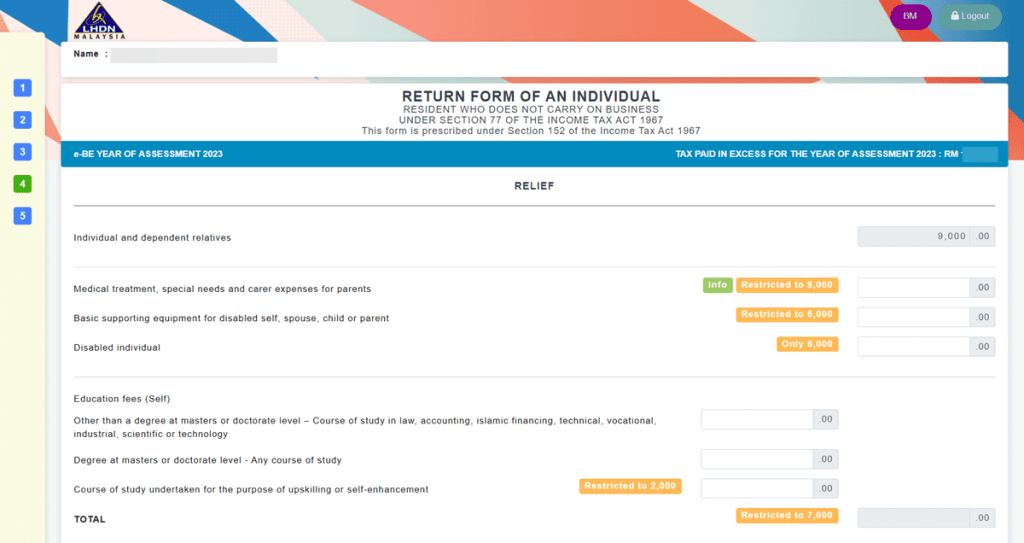
This section is the main reason why you need to look through all your spending receipts from the previous year and keep the relevant ones! As we’ve mentioned earlier, tax reliefs will help to reduce your chargeable income (and therefore your tax rate and tax amount), so be sure to claim everything that you’re eligible for.
You can find the full list of tax reliefs that you can claim for YA 2023 here (along with detailed explanation for each relief), but we’ve also prepared an infographic for those who just want a checklist for quick reference – you can check it out here:

Once you’ve claimed all your tax reliefs, you’ll arrive at your chargeable income – which determines the tax rate that is applicable to you, as well as the amount of tax that you need to pay for YA 2023. With some luck (and a lot of diligence on your part), you would – hopefully – have reduced the amount of tax payable by a fair bit!
Don’t forget to also check on any of the tax rebates that are applicable to you, which are deducted straight from amount of tax that you need to pay. As you can see in the infographic above, you will be eligible for a tax rebate of RM400 for yourself if your chargeable income does not exceed RM35,000. Zakat and fitrah, too, can be claimed as tax rebates for the actual amount expended (up until the total tax amount).
So let’s put this into an actual scenario to help you see how it all works. Let’s assume that your total income for YA 2023 stands at RM50,000, and you have claimed RM15,000 in tax relief. This brings your chargeable income down to RM35,000 – which mean that the amount of tax you must pay is RM600. As your chargeable income is borderline RM35,000, you will not be eligible for the RM400 tax rebate provided for individuals who earn less than RM35,000. However, if you did contribute RM400 on zakat in the previous year, then you can deduct that as tax rebate. Ultimately, you will end up with a final tax amount of RM200 to pay.
v) Check your summary
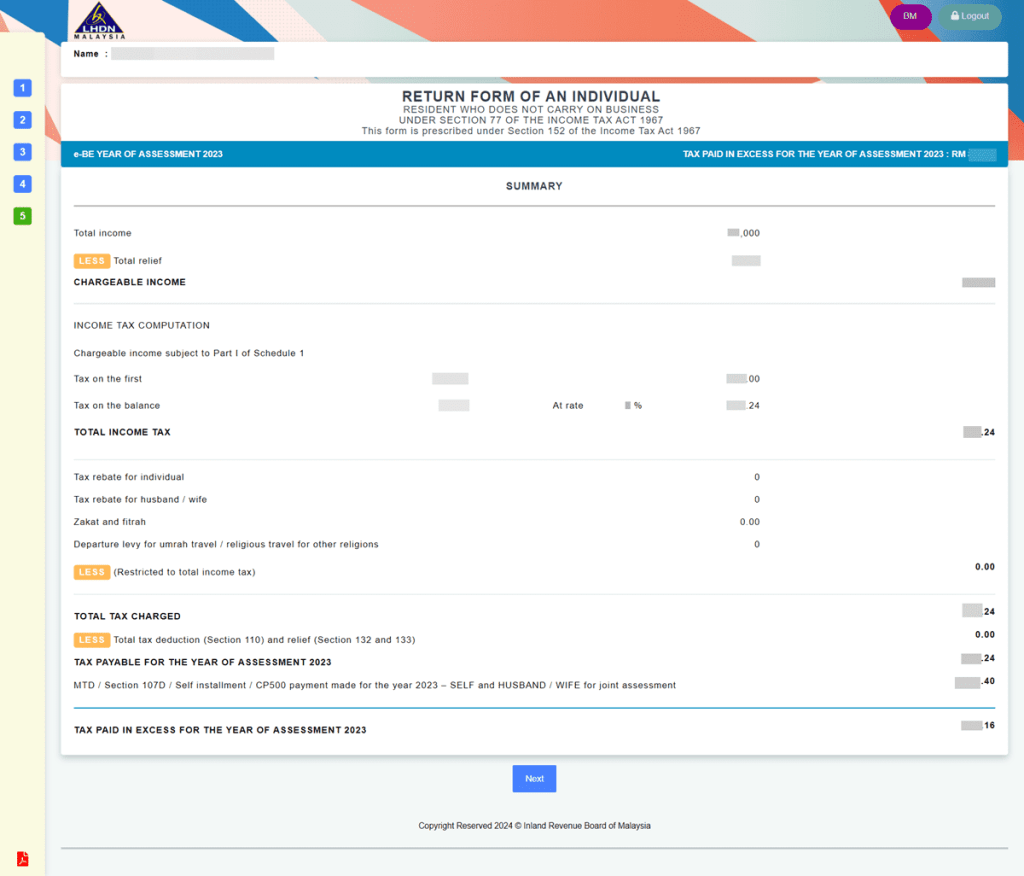
Now that you’re at the summary page, your tax filing work for the year is almost done! On this page, you should see the final tax amount displayed. Do not worry if your tax amount is in the negative; this is due to the advanced tax payments that you have already made through MTD (it means that you will get a tax refund from the government).
If you notice any mistakes at this stage, you’re still free to go back to previous sections of your ITRF to make amendments; the form will automatically update the final tax amount on the summary page. Once you’re confident that your form is error-free, click “Next”.
On the declaration page, request a TAC via the number that you’ve registered with LHDN and key it in. Then, click the “Sign and Submit” button, enter your identification number and password in the pop-up window (remember to allow pop-ups on your browser for this), and press the sign button.
And with that, congratulations on fulfilling your duty as a responsible citizen! Just one last thing before you exit the website and proceed to pay your taxes (if you need to): save and print the acknowledgement and e-BE form for record purposes, and keep them together with your collected receipts! These receipts must be kept for a minimum of seven years in case LHDN wishes to audit and clarify matters with you.
Amending your income tax form

Here’s a reminder for you to be as careful as possible when filing your taxes, but if you happen to find any errors in your ITRF not too long after submitting it, no need to panic! You can still fix the mistake(s) by sending in an appeal for amendments by 30 April 2024. Just take the following steps:
- Print your e-Form and make the relevant corrections on the form (you will also need to initial these corrections to verify them)
- Manually calculate your taxes up to the “Tax Paid” level
- You’ll also have to prepare a letter of appeal to clarify the corrections and changes that you’ve made
- Send the amended form and letter of appeal to the LHDN branch that is handling your tax file (or you can visit a LHDN branch personally, if you prefer)
- Remember to also attach all the supporting documents required (e.g. a copy of your EA form, receipts, invoices, and others)
It is also possible for you to submit these documents through the LHDN Customer Feedback Portal (via “Enquiry”). Note that LHDN will go through each error appeal as part of the audit process, and the time taken for the amendments to be approved/reflected will depend on the accuracy of the information and documents submitted. You can actually also make online amendments via e-Filing, but note that this is only applicable for two specific circumstances: over-declaration of income and underclaimed tax relief or rebates. Additionally, you must have submitted your BE Form before the submission deadline in order to use this method.
To access this service, just head on over to your MyTax dashboard, click on e-Filing, followed by “e-Application for Amended BE”. Fill in the form and submit it.
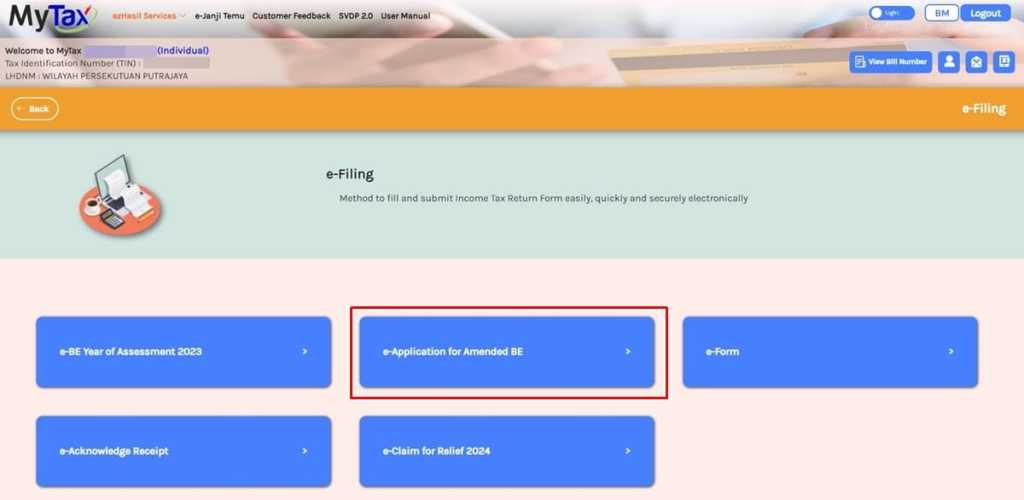
As for those who need to amend their ITRF after 30 April, you’re still allowed to submit an amended return form (ARF) within six months from the ITRF submission deadline. Your ARF must also be sent to the branch that handles your income tax file, and only taxpayers who have submitted their ITRF on time for the year is allowed to send in an ARF. Again, this ARF is only necessary for the following errors:
- Under declared or undeclared income
- Overclaimed expenses or other claims
- Overclaimed capital allowances, incentives, and reliefs
If you’ve made other errors aside from those listed above, you’re not required to send in an ARF. Instead, you can forward a detailed letter on the mistakes made and enclose any relevant documents to support your application.
Paying your income tax

Now that your taxes are filed, and your final tax amount determined, you’ll find yourself in one of the following situations:
1) You may receive a tax refund
For those who’ve been paying MTD/PCB every month, you may find that your tax reliefs and rebates can sometimes reduce your final tax amount to the point where it is less than the total MTD that you’ve paid throughout the year. If this happens, then you’re eligible for a tax refund because you’ve overpaid your taxes. The refund will be automatically credited to the bank account that you’ve provided in your tax form, usually within 30 days after your tax submission.
2) You need to pay taxes
On the other hand, if you find that after the filing, you still owe more taxes, you’ll have to pay them before the due date. Here are several ways for you to make your payments conveniently:
| Method | Details |
| Online banking via FPX (either using tax identification number (TIN) or a bill number) | Requires a bank account with Affin Bank, Alliance Bank, AmBank, Bank Islam, Bank Muamalat, Bank Rakyat, Bank Simpanan Nasional, CIMB Bank, Deutsche Bank, Hong Leong Bank, HSBC Bank, Kuwait Finance House Malaysia, Maybank, OCBC Bank, Public Bank, RHB Bank, Standard Chartered Bank, or UOB Bank |
| Credit cards via ByrHASiL* | Visa, Mastercard, American Express (AMEX) accepted |
| Debit cards/credit cards at Revenue Management Centres (over the counter) | – Available at the Kuala Lumpur Revenue Management Centre, Kota Kinabalu Revenue Management Centre, and Kuching Revenue Management Centre – Admin charge of 0.8% applies for credit card payments |
| Pos Malaysia (over the counter) | Cash only |
| Automated teller machines (ATM) | Only at CIMB Bank, RHB Bank Maybank, and Public Bank |
| Cash deposit machines (CDM) | Only at Maybank |
As mentioned, credit card payments are currently unavailable online until a date to be notified later. Do note that almost all banks do not provide benefits (cashback or rewards points) for government-related spending on their cards. However, some allow such expenses to included as part of your monthly or annual spend requirements that go towards unlocking higher cashback tiers or annual fee waivers – so it’ll be on you to evaluate if it would make sense for you to pay your taxes using a credit card!
Also, take note that the government has now made it mandatory to use bill numbers as the reference for your tax payments, as opposed to your tax identification number (TIN) – which was previously the case. This change has been implemented since 1 January 2023, but to help ease the transition, we are still allowed to use TIN as our payment reference for now – also until further notice.
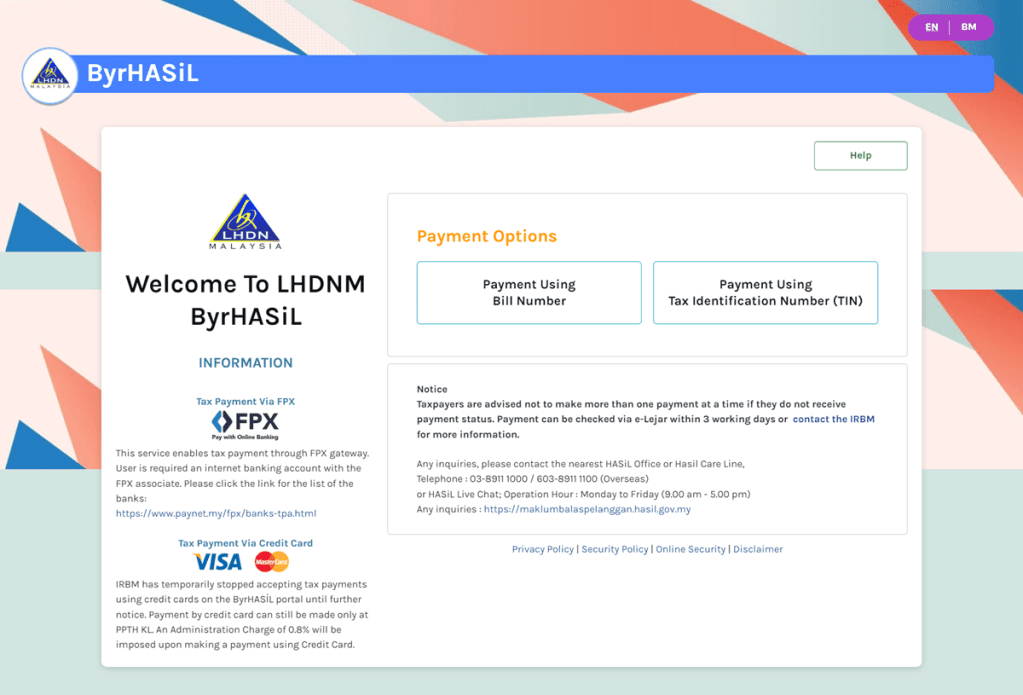
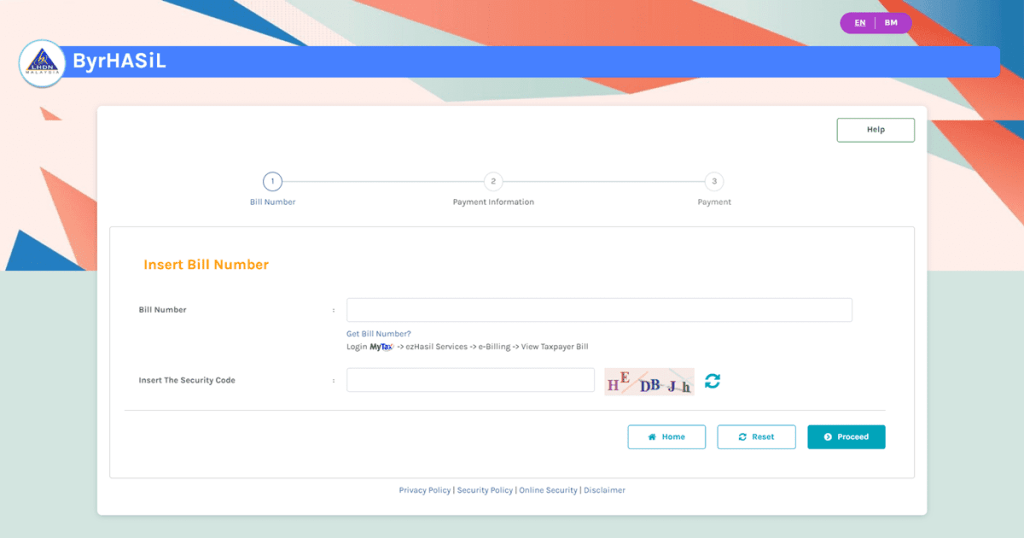
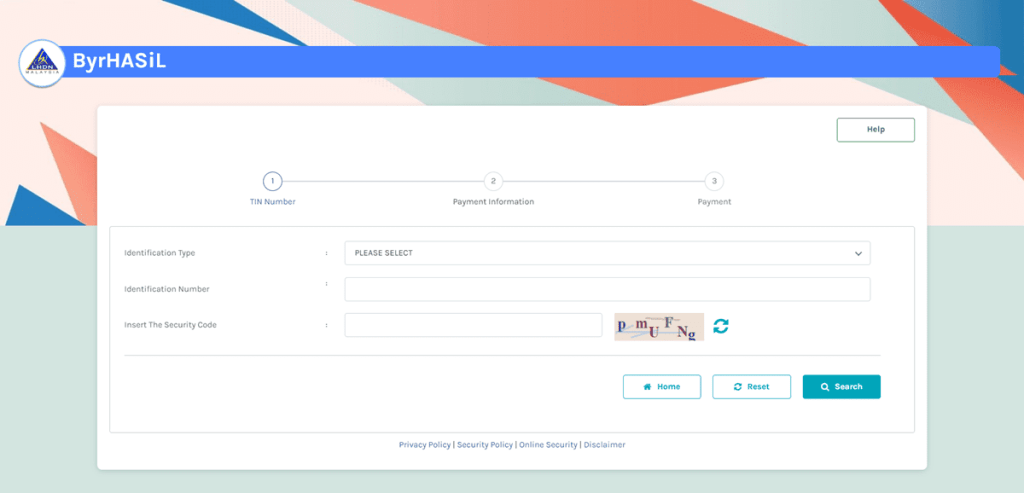
To explain, the bill number is a 16-digit number that is meant to help LHDN track your tax payments more effectively, and is applicable to all types of tax payments except for MTD/PCB and stamp duties. You can obtain your bill number from your MyTax dashboard; just click on the “View Bill Number” button on the top right corner (your bill number will be automatically generated here once you submit your ITRF via e-Filing, with indication that you have tax to pay).
Meanwhile, for those of you who are still filing your taxes manually, note that you’ll also be required to generate your bill number via MyTax when LHDN eventually phases out the use of TIN as tax payment reference. In this situation, the process may be slightly more tedious because you cannot just click on “View Bill Number” (your bill number is not automatically generated on MyTax since you did not use e-Filing to file your taxes online). Instead, you’ll need to click on “ezHasil Services” >> “e-Billing” >> “Generate Bill”.
As for those who are residing abroad and need to pay your taxes, you’ll need to use a separate Electronic Telegraphic Transfer (e-TT) service to generate an additional virtual account (VA) number, on top of the bill number. (Note: Taxpayers living within Malaysia may sometimes opt to pay their taxes via e-TT as well. In such cases, you’ll also need to generate a VA number. However, most locals typically use FPX payments for convenience.)
Late income tax payments

You will be hit with a penalty of 10% on the balance of tax unpaid after the deadline (30 April or 15 May). You can forward an appeal, however, if you disagree with the penalty. You’ll need to write to the Collection Unit of LHDN within 30 days of being issued a Notice of Increased Assessment. Note that you are required to settle the penalty imposed first, even if you wish to appeal. If your appeal is successful, then LHDN will refund the relevant amount at a later date.
Aside from the penalty for late income tax payments, you may also want to take note of the penalties for other offences, such as:
- Failure to file your taxes: RM200 to RM20,000 penalty, or imprisonment (not exceeding six months), or both
- Omitting or understating income while filing tax: RM1,000 to RM10,000 penalty and 200% of tax undercharged
- Wilfully evading tax/assisting others: RM1,000 to RM20,000 penalty, or imprisonment (not more than three years), or both and 300% of tax undercharged
Appealing your income tax notice of assessment
After filing your taxes, LHDN may serve you a notice of assessment, which is a written statement that states your taxable income, amount of tax due, and so on.
Be sure to go through everything, and if you find any discrepancies or errors, you can file an income tax appeal. This must be done within 30 days from the date of notice in writing to the LHDN branch that issued the assessment.
To do so, fill in the Q form and write a letter to identify the discrepancies that you see. Of course, you’ll also need to attach supporting documents that are relevant to clarify your claims, including a copy of your ITRF. The appeal will then be forwarded to the Special Commissioners of Income Tax.
If you miss the 30-day deadline, however, you can use the N form to apply extension of time for the appeal. Only valid reasons are allowed, such as having been hospitalised for a long period or absence from the country. If your application of extension for time is approved, you’ll be issued a Form CP15A, and you must submit the Q form within thirty days from the date of issuance of your Form CP15A. You can download both the Q and N forms from the LHDN website.
When to stop filing taxes?

You are allowed to stop filing taxes only when you have permanently closed your tax files, namely under these circumstances:
- A retiree with no taxable income
- An individual who is leaving Malaysia for good
- An individual aged 55 and above, with no taxable income
So if you’re a retiree who’s still taking up the occasional freelance jobs (with income not exceeding RM34,000 per annum), or a 45-year-old individual with no taxable income, you’ll still be required to continue filing your taxes.
We should reiterate here that tax filing is essentially a matter of accountability, where you declare what you’ve earned in the previous year. It does not necessarily mean you have to pay taxes; you’re only required to pay taxes if your chargeable income meets the threshold.
Meanwhile, if you’re entitled to close your tax file permanently and would like to do so, you can send an official letter to the LHDN branch that handles your file. Make sure to check ahead of time that there are no outstanding amount that needs to be paid, or a pending refund status.
*****

Hopefully, this guide has useful in guiding you along the process of filing your taxes for 2024 (YA 2023). You can also check out our other tax articles for this year, including:
- Everything You Should Claim As Income Tax Relief 2024 (YA 2023)
- Income Tax Malaysia: What’s New For YA 2023?
- How To File Your Taxes For The First Time
- How To File Your Taxes As A Freelancer
- How To File Income Tax For Your Side Business
- How To File Your Taxes If You Changed Or Lost Your Job Last Year
- How To Claim Income Tax Reliefs For Your Insurance Premiums

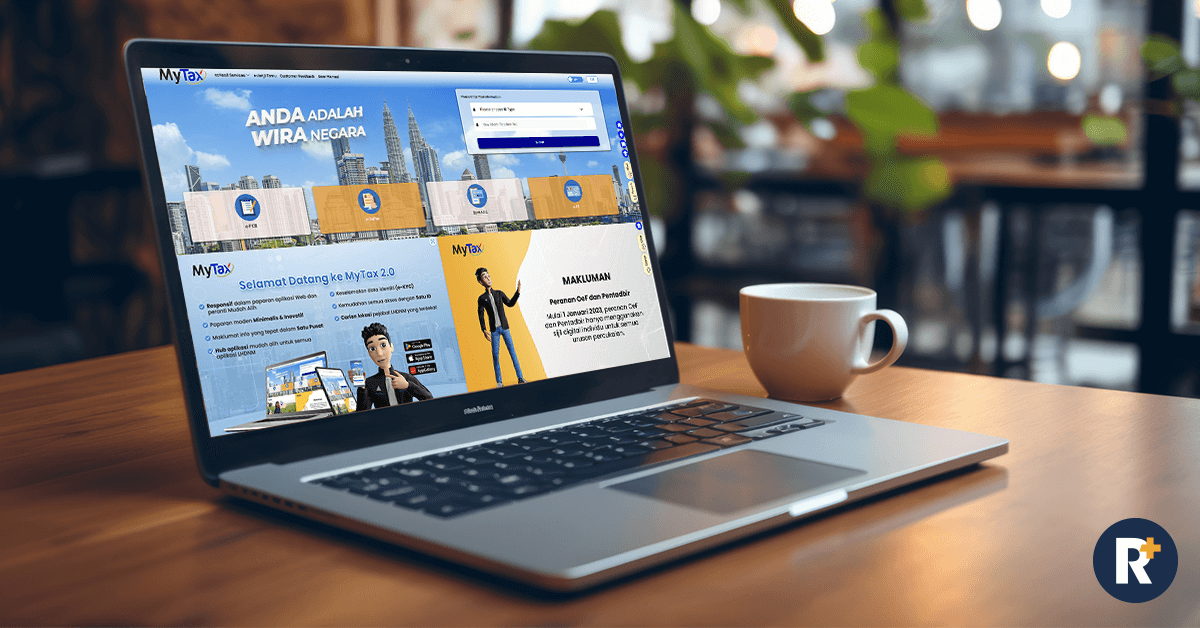
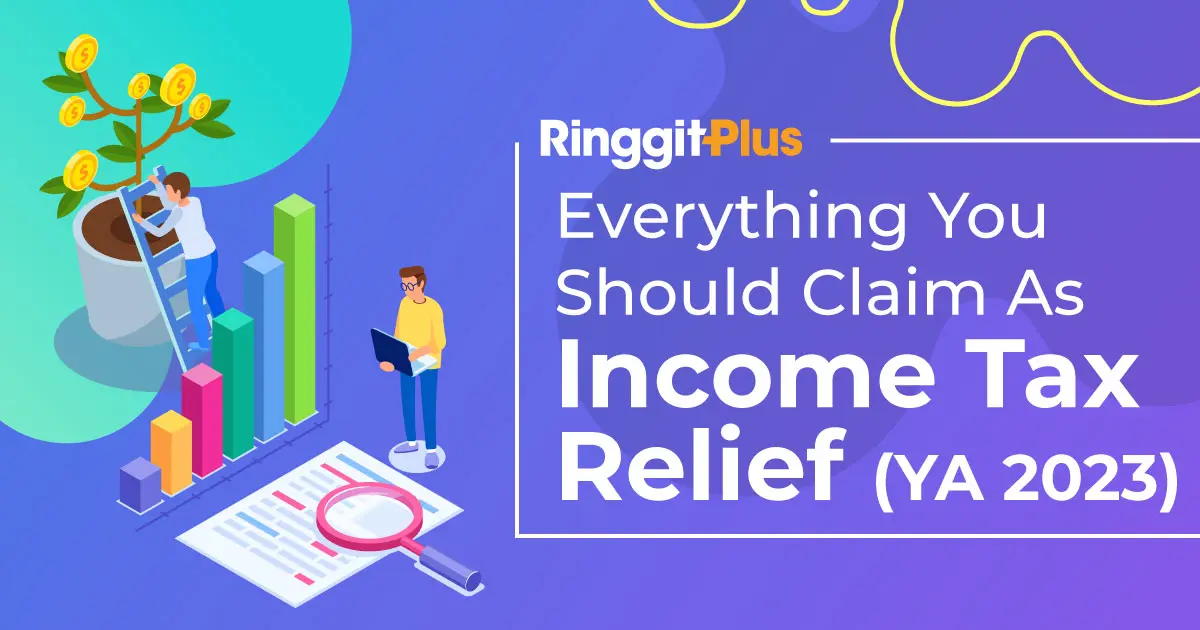






Comments (51)
Very good article. Can you help to advise on my situation. My company (Malaysia) is sending me to work oversea and salary will be paid in Malaysia as usual. I will be staying oversea most of the time. How will the income tax likes ? Thank you
Hi Andy,
Thanks for the kind words!
If you’re paid in Malaysia, your salary is usually taxed in Malaysia, even if you’re working overseas, as long as you’re a tax resident. If you’re a non-resident, the tax rules could differ. It’s best to consult a tax advisor for specific details.
Is an individual (aged 55 and above) who is leaving Malaysia for good (but still have taxable rental income) eligible to apply for closure of tax account?
Yes, if you’re leaving Malaysia for good but still have taxable rental income, you may be eligible to apply for the closure of your tax account. However, as long as you have taxable income, such as rental income, you may still need to file taxes until your tax residency status changes. It’s advisable to consult the IRB (Inland Revenue Board) for guidance on the proper process.
any version 2025?
Hey! The 2025 version (for YA 2024) isn’t out yet. Stay tuned!
Hi Alex, Thanks for that insightful article. I’m new in Malaysia and I would like to ask a question you may know… I arrived in Malaysia on 14th of September 2024 to work in KL (local contract). I understood I should file the tax form M as no resident in 2025 before end of April. Could I request in that form M a tax refund for the tax excess I paid during 2024 (30% as no resident) compared to the “resident” tax I will pay during 2025? I’m not sure whether I should be considered resident in 2024, linking 182… Read more »
You can request a tax refund in 2025 if you’re considered a tax resident in that year. To be a resident, you need to stay in Malaysia for 182 days or more in 2025, and short holidays within the 14-day limit won’t break this.
You’ll file the tax form M by April 2025 and can request a refund for the excess tax paid in 2024 once your residency status is confirmed.
Hope that helps!
Hi, this article is very helpful. Could you help me address a concern I’ve been having over the past few months? I am an Indonesian citizen who has been working for a company located in Malaysia for the past year. I work remotely from home and remain in Indonesia; I am not in Malaysia, and I do not hold an Employment Pass. **Question: Do I need to report my income tax and pay income tax in Malaysia? A little background: A few months ago, the company registered me as a taxpayer. The tax deducted every month is around 30%, so… Read more »
Glad the article was helpful!
Since you’re working remotely in Indonesia, you may not need to pay tax in Malaysia, but the company might be withholding tax due to local regulations. It’s best to consult a tax professional in Malaysia for clarification and check Indonesia’s tax rules to avoid double taxation.
I understand the frustration with the high tax rate! Hope this helps!
Thank you Alex for the information. Wondering could you help me out with my situation: I’m Malaysian (married to Irish with kids) but living in Ireland. I’m a non resident Malaysian. But I’ve been receiving rental back in Malaysia. And I have a query about Tax. The rental comes to around Rm18k, and currently asked to pay tax at 30%. According to the T&C of the Form M: YOU WILL NOT BE TAXABLE IF – Employed in Malaysia for less than 60 days. I’ve not been working in Malaysia at all. So, do I fall in this not taxable category?… Read more »
Since you’re a non-resident earning rental income in Malaysia, the 30% tax typically applies to that income. The 60-day exemption only covers employment in Malaysia, so it doesn’t apply to rental income.
For any specific exemptions, it may be helpful to check with LHDN or a tax advisor for clarity on your situation.
Hi Alex, First, thank you for the helpful article. Could you please kindly confirm whether I understand my filing requirements correctly? I’m here on a De Rantau Digital Nomad Pass, earning foreign income while residing on Malaysian soil. I have valid Nomas Pass /visa/ since 21 Sept 2023. I have my TIN number. My income from my freelance digital work performed on Malaysian soil since September 21, 2023, until December 31, 2023, is less than the 2023 income taxable trashhold of 37.333 MYR (but overall year income exceeded). Do I have to file taxes for 2023, or should I just… Read more »
Hey Peter!
It sounds like you’ve got a good handle on your situation, but you might still need to file taxes for 2023, even if your income here is under the taxable threshold. It’s usually a good idea to file just to stay on the safe side, especially if your overall income for the year is above the limit.
I’d recommend checking with a tax pro or the LHDN directly to make sure you’re all set. Better safe than sorry, right?
Hi Alex! Thank you for this helpful article. Can you kindly confirm whether I understand my filing requirements correctly, based on timing? I’m here on a De Rantau Digital Nomad Pass, earning foreign income while residing full-time on Malaysian soil.
I moved to Malaysia 26 Dec 2023 (no income earned in 2023). Therefore, I did not file taxes for 2023. I will earn foreign income throughout 2024. Does this mean my FIRST filing should be the B form by 30 June 2024 (manual filing) or 15 July (e-Filing)?
Thank you in advance!
You’ve got it mostly right. Since you’re earning foreign income in 2024, your first tax filing will be for that year. You’ll need to submit the B Form by:
Manual Filing: 30 June 2025
e-Filing: 15 July 2025
So, you’ll be filing for the 2024 income by these deadlines in 2025.
Yep, you caught my year typo 😉 Thank you for that, and for confirmation of the correct process/filing time. Much appreciated Alex!
Glad I could help! 😊 If you need anything else, feel free to reach out. Thanks, and take care!
Hi, I’m a Malaysian residing in Brunei and working freelance as a web developer for some Malaysian clients. Do I need to declare my income in Malaysia? I have a tax file in Malaysia. There’s no personal income tax in Brunei. I come back to Malaysia maybe for a few weeks every year.
Yep, you’ll need to declare your freelance income in Malaysia since you’re a tax resident there. Brunei’s tax rules don’t change that. If you’re unsure, a tax advisor can help with the details.
Good afternoon, first time taxpayer since back from Singapore, i did the bank transfer CPF withrawal money from Sg bank to Malaysia bank account last year and this year, do i need to declare in tax exempt income from sources outside Malaysia received in Malaysia? Thank you.
If you’ve transferred CPF withdrawal money from a Singapore bank to a Malaysian bank, you usually don’t need to declare it as it’s considered foreign-sourced income and is typically tax-exempt in Malaysia. For more accurate info, please contact LHDN.
Hi! I am a first time tax payer here and I was hoping you could assist me with something I’m facing. I reached the declaration page but I couldn’t find the link to request TAC (in website) on it. Besides the important reminder and print draft option, there’s just the sign and submit button. Do we need to request for the TAC (phone number listed without the country code) or can just click sign and submit?
Make sure your phone number is registered correctly for the TAC link. Usually, you need it before clicking ‘Sign and Submit’. If it’s missing, reach out to LHDN for help.
Hi. I’m a real estate agent in Malaysia and would like to know, should I declare my income tax under Form B or Form BE? I have no idea on how to classify my income source, hope to get some clear indications here. Thank you.
If we made an appeal to correct the income tax filing mistake for past years (eg. 2020, 2021), all documents are submitted at the office. How long does it take to hear back whether the appeal is successful? How do i follow up?
Typically, it can take a few weeks to a few months to hear back about the appeal. You can follow up by contacting the tax authority directly.
Hello, I stopped working in February 2022, and did not earn a taxable income that year. I was under the impression that I wouldn’t need to file for 2022. Was just told that’s incorrect. What do I do under this circumstances, and will I get charged a penalty even though I didn’t earn enough to be taxed in 2022. Thanks.
If you didn’t earn a taxable income in 2022, you might not need to file taxes. You can contact LHDN for the necessary steps to take.
Actually you do need to file every year as long you have a tax file that remains open. Even if you don’t have a taxable income for that year. Leaving this comment here in case it helps anyone else. Thanks for replying.
Thanks for sharing this helpful reminder!
Hi, I am a Malaysian and married to a British diplomat who was posted to KL for 5 years till 2022. I worked in a P/T role for just over 2 years before I left and filled up income tax returns but because of the puny salary involved, didn’t have to pay tax. I previously filled up the tax exempted column for my husband when picking assessment type. We returned to the UK in 2022 and I didn’t think to let LHDN know of this. I did e-filing last year for the 2022 income and want to continue doing e-filing… Read more »
Hey, given your unique situation with a British diplomat spouse and considering e-filing as a non-resident, it’s definitely worth reaching out to LHDN directly for guidance.
Hi, I wish to inquire, a retired individual who used to have rental income in the past but as of now all the properties been sold out in Year 2022, therefore this individual got no more income for A 2023, does this individual need to write in letter to LHDN to inform the individual will not have any income for the foreseeable future and to close the income tax file number? If yes, do you able to assist me on the drafting of the letter? Thanks
You don’t need to write a formal letter to LHDN. You can simply inform them about your change in circumstances over the phone or by email.
Alex, would appreciate your advise on d following:
My mother passed away in March 2023 n i have inherited fr her, couple of properties namely houses. A considerable amount was paid for legal fees to transfer d properties to my name. All duly done n legal fees paid in 2023 itself. Question is :
A) Are d full amount paid to d lawyers for transfer, tax deductible??
B) Or just certain portions, pls specify if this is d case.
C) Are tax deductions allowed for Probate issuance fr High Court ??
Any advice is highly appreciated.
Thank you in advance.
Hey Ed, I’m sorry for your loss. Regarding your questions:
A) Generally, legal fees paid for the transfer of inherited properties are not tax-deductible.
B) However, there might be specific portions related to the transfer that could be deductible. It’s best to consult with a tax advisor for more advice.
C) As for probate issuance fees, they may or may not be tax-deductible depending on the tax laws in your jurisdiction. Again, consulting a tax pro would provide you with the most accurate information. Take care!
Hey Ed, I’m sorry for your loss. Regarding your questions:
A) Generally, legal fees paid for the transfer of inherited properties are not tax-deductible.
B) However, there might be specific portions related to the transfer that could be deductible.
C) As for probate issuance fees, they may or may not be tax-deductible depending on the tax laws in your jurisdiction. Again, consulting a tax pro would provide you with the most accurate information. Take care!
This article is super helpful and refreshingly concise. Being a returning Malaysian working in KL now and filing income tax for the first time in Malaysia, can you help me with two questions. As my spouse is a foreigner, her ID details for some reason cannot be entered into the Tax Portal as it recognizes only Malaysian related IDs. How do I circumvent this snag? Secondly, as I have successfully been approved under the Returning Experts Program where a flat rate of 15% is applicable, how can I apply that tax rate for 2023; as there not does seem to… Read more »
Glad you found the article helpful. Regarding your questions, I recommend reaching out to LHDN directly for help with entering your spouse’s ID details into the Tax Portal and applying the special tax rate for the Returning Experts Program. They should be able to provide the necessary guidance and support to help you navigate through these issues.
Greetings, I am a foreigner married to a Malaysian. I am employed by a company in Singapore and we have been on a WFH arrangement since the pandemic. As a result, I can stay with my husband in Malaysia (I hold an LTVP). Eventually, my SG work pass was canceled by my employer in May 2023 as it was no longer needed since I could continue working remotely for them. Is it correct that I should file my income tax here in Malaysia and not in SG?
Hello! Based on your situation, since you’ve been residing in Malaysia and working remotely for your Singapore employer, it’s likely that your tax obligations would be in Malaysia. However, to ensure accuracy, I’d recommend consulting with a tax advisor or contacting the Malaysian tax authority for personalized guidance. Best wishes!
Hi, first-time taxpayer here! Thank you so much for the information. It gave me so much clarity and understanding. I have one question hoping you could answer me. I recently started working last month and it is my first job after graduation. Should I open an account in myTax now or should I wait until next year? If my understanding is correct, I should open it next year right since I don’t have a chargeable income yet. I tried contacting LHDN through various means but they haven’t gotten back to me. Thank you!
Hi there! I’m glad the information was helpful for you. Since you’ve just started working and don’t have a chargeable income yet, you can wait until next year to open an account in myTax. It’s always good to be proactive, but you can focus on it when you have taxable income to report. Feel free to reach out if you have any more questions!
Thank you Alex!
Thank you
Something that is similar to unit trust fund, I also put some money in “cash management solutions” from Versa Asia Sdn Bhd (“VERSA”), a fintech company that teamed up with Affin Hwang AM and I put money only in a specific fund named (“VERSA SAVE”) which is also a kind of money market fund, Affin Hwang’s Enhanced Deposit Fund which only invests in low-risk assets – short term deposits in multiple Malaysian banks. So for any interest earned, do I need to indicate/declare it in my income tax filing? Please advise. Thanks.
It’s great to hear about your investment. It’s recommended to consult with a tax professional for advice on declaring interest earned from VERSA’s cash management solutions in your income tax filing. Thanks!
interest earned is not considered as income (just as with your FD and CASA interest)
Very good 👍
Thank you for your positive feedback! We’re glad you found the content helpful. If you have any questions or topics you’d like us to cover in the future, feel free to let us know. Your input is appreciated!